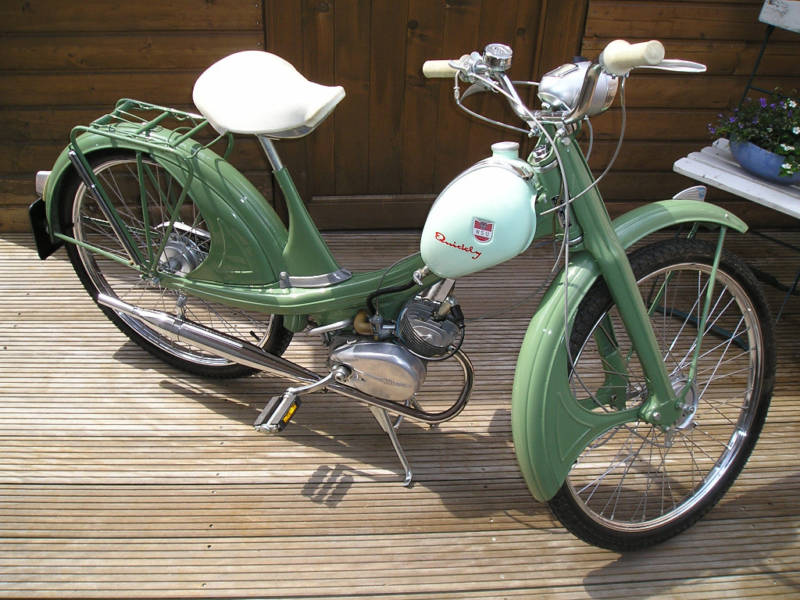Timeless Mobility: The Legacy of the 1959 NSU Quickly
The article delves into the legacy of the 1959 NSU Quickly moped, highlighting its significance as a symbol of post-war innovation and mobility. It explores the genesis of the NSU Quickly, its design and specifications, as well as its impact and lasting legacy in popular culture and the automotive industry.
TWO STROKE1950'SVINTAGE MOPEDSNSU GERMANY
4/1/20243 min read


Timeless Mobility: The Legacy of the 1959 NSU Quickly
Introduction
The NSU Quickly moped stands as a testament to post-war innovation and simplicity in mobility. This iconic two-wheeler, introduced by NSU Motorenwerke AG of Germany in 1953, burgeoned into a symbol of freedom and efficiency against the backdrop of Europe's recovery from the devastations of World War II. Its name, emblematic of the era's shift towards fast, economical transportation options, heralded a new chapter in the realm of two-wheeled travel. With over one million units sold, the Quickly carved its niche not just as a mere vehicle but as a cultural phenomenon, marrying the need for affordable mobility with the desire for independence.
By 1959, the Quickly had already established itself as an integral part of the urban landscape, navigating the bustling streets and serene countryside with equal aplomb. Its unparalleled success pivoted on a combination of innovative design, reliability, and affordability, rendering it the preferred choice for a wide swath of the population. As we delve into the history and legacy of the 1959 NSU Quickly moped, we uncover the qualities that transformed it from a simple mode of transportation to an enduring icon of the 20th century.
The Genesis of the NSU Quickly
The birth of NSU Motorenwerke AG dates back to 1873, initially thriving as a manufacturer of knitting machines before paving its way into the automotive realm. The transition to producing bicycles and, subsequently, motorcycles and automobiles underscored NSU's adaptability and innovative spirit. The introduction of the NSU Quickly in 1953 marked a milestone in the company's history, establishing NSU as a pioneer in the moped market.
The Quickly's inception was a direct response to the societal shift towards more economical and practical transportation solutions in the aftermath of World War II. Its design focused on simplicity, reliability, and affordability, principles that resonated deeply with the public's needs during the period of reconstruction and economic recovery. Over the next fifteen years, the Quickly's popularity soared, with over one million units sold, making it the most popular moped of its time and a testament to NSU's vision and engineering prowess.
The Quickly was more than just a moped; it symbolized a new era of mobility where efficiency and accessibility were paramount. Its success paved the way for NSU's continued innovation in the automotive industry, reinforcing the brand's legacy as a vanguard of transportation solutions.
The 1959 NSU Quickly - Design and Specifications
The 1959 NSU Quickly model stood at the intersection of design elegance and mechanical innovation, embodying the perfect blend of form and function that would come to define this iconic moped. Among the most notable specifications of the 1959 Quickly were its 49cc two-stroke single-cylinder engine, capable of delivering a modest yet practical power output of around 1.5 to 2.2 horsepower, depending on the model variation. This engine was paired with a 2-speed manual transmission, allowing riders to navigate varying terrains with ease.
Design-wise, the 1959 Quickly offered a streamlined aesthetic that was both retro and modern. Its lightweight frame, which significantly contributed to the moped's nimble handling, was complemented by a simplistic yet functional layout. The Quickly's leading link front suspension provided a relatively smooth ride, a notable feature given the sometimes rough post-war road conditions. Moreover, its drum brakes, both front and rear, ensured reliable stopping power.
In addition to its technical specifications, the 1959 NSU Quickly boasted features that catered to the practical needs of its riders. The inclusion of a luggage rack, for example, highlighted NSU's understanding of the moped's role not just as a vehicle for leisurely rides but as a workhorse capable of carrying small loads. This attention to detail in design and functionality underscored the Quickly's appeal across various demographics, further cementing its place in moped history.
The Impact and Legacy of the NSU Quickly
The impact of the NSU Quickly, particularly the 1959 model, extended far beyond its immediate utility as a mode of transport. It emerged as a beacon of post-war mobility, enabling a generation to embrace the freedom of movement and independence. The Quickly became an integral part of daily life for many, utilized for commuting, leisure, and everything in between, marking a significant shift in how individuals interacted with their environment.
Its widespread adoption laid the groundwork for the moped culture that flourished in Europe and beyond. The NSU Quickly's influence permeated motorcycle clubs, rallies, and even the budding mod culture of the 1960s, signifying its role not just as a vehicle but as a lifestyle emblem. The moped's legacy is evident in the continued enthusiasm of vintage motorcycle enthusiasts, who restore and celebrate the Quickly as a piece of motoring history.
Moreover, the NSU Quickly's impact is reflected in its enduring presence in popular culture, appearing in films, literature, and art as a symbol of mid-century modernity and the democratization of mobility. This cultural footprint, combined with its technological contributions, cements the NSU Quickly, and particularly the 1959 model, as a historical artifact that encapsulated the spirit of an era.
